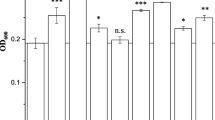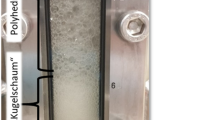Abstract
In this study, N-hexanoyl-homoserine lactone (C6-HSL), a member of the N-acyl-homoserine lactone class of microbial quorum sensing (QS) signaling molecules, was used to improve microbial flocculant production. After exogenous C6-HSL was added, exopolysaccharide concentration of microbial flocculants was improved by 1.6-fold and flocculation rate of microbial flocculants was increased by 10 %. Fermentation conditions with added C6-HSL were further optimized through response surface methodology. The obtained optimal fermentation conditions were as follows: added C6-HSL concentration of 0.45 μM, fermentation temperature of 30.4 °C, and initial fermentation pH of 7.25. Under these optimal fermentation conditions, the resulting exopolysaccharide concentration was improved by 1.75-fold and flocculation rate was increased by 10 % compared with that of the control group. The yield of microbial flocculants was also improved by 1.75-fold. Results demonstrated that the existence of QS system in Agrobacterium tumefaciens strain F2 played the important roles in the microbial flocculant production.





Similar content being viewed by others
References
Salehizadeh, H., & Shojaosadati, S. A. (2001). Extracellular biopolymeric flocculants: recent trends and biotechnological importance. Biotechnology Advances, 19, 371–385.
Patil, S. V., Salunkhe, R. B., Patil, C. D., Patil, D. M., & Salunke, B. K. (2010). Bioflocculant exopolysaccharide production by Azotobacter indicus using flower extract of Madhuca latifolia L. Applied biochemistry and biotechnology, 162, 1095–1108.
Shrout, J. D., & Nerenberg, R. (2012). Monitoring bacterial twitter: does quorum sensing determine the behavior of water and wastewater treatment biofilms? Environmental science & technology, 46, 1995–2005.
Gilbert, K. B., Kim, T. H., Gupta, R., Greenberg, E. P., & Schuster, M. (2009). Global position analysis of the Pseudomonas aeruginosa quorum-sensing transcription factor LasR. Molecular microbiology, 73, 1072–1085.
Sakuragi, Y., & Kolter, R. (2007). Quorum-sensing regulation of the biofilm matrix genes (pel) of Pseudomonas aeruginosa. Journal of bacteriology, 189, 5383–5386.
Rinaudi, L. V., & González, J. E. (2009). The low-molecular-weight fraction of exopolysaccharide II from Sinorhizobium meliloti is a crucial determinant of biofilm formation. Journal of bacteriology, 191, 7216–7224.
Wang, M. Z., Zheng, X., He, H. Z., Shen, D. S., & Feng, H. J. (2012). Ecological roles and release patterns of acylated homoserine lactones in Pseudomonas sp. HF-1 and their implications in bacterial bioaugmentation. Bioresource technology, 125, 119–126.
Tan, C. H., Koh, K. S., Xie, C., Tay, M., Zhou, Y., Williams, R., Rice, S. A., Ng, W. J., & Kjelleberg, S. (2014). The role of quorum sensing signalling in EPS production and the assembly of a sludge community into aerobic granules. The ISME journal, 8, 1186–1197.
Wang, L., Ma, F., Qu, Y., Sun, D., Li, A., Guo, J., & Yu, B. (2011). Characterization of a compound bioflocculant produced by mixed culture of Rhizobium radiobacter F2 and Bacillus sphaeicus F6. World Journal of Microbiology and Biotechnology, 27, 2559–2565.
Li, A., Geng, J., Cui, D., Shu, C., Zhang, S., Yang, J., & Hu, S. (2011). Genome sequence of Agrobacterium tumefaciens strain F2, a bioflocculant-producing bacterium. Journal of bacteriology, 193, 5531.
Fuqua, W. C., Winans, S. C., & Greenberg, E. P. (1994). Quorum sensing in bacteria: the LuxR-LuxI family of cell density-responsive transcriptional regulators. Journal of bacteriology, 176, 269.
Eberhard, A., Burlingame, A. L., Eberhard, C., Kenyon, G. L., Nealson, K. H., & Oppenheimer, N. J. (1981). Structural identification of autoinducer of Photobacterium fischeri luciferase. Biochemistry, 20, 2444–2449.
Kurane, R., Hatamochi, K., Kakuno, T., Kiyohara, M., Hirano, M., & Taniguchi, Y. (1994). Production of a bioflocculant by Rhodococcus erythropolis S-1 grown on alcohols. Bioscience, biotechnology, and biochemistry, 58, 428–429.
Elibol, M. (2004). Optimization of medium composition for actinorhodin production by Streptomyces coelicolor A3 (2) with response surface methodology. Process Biochemistry, 39, 1057–1062.
Chan, M. M. Y. (2002). Antimicrobial effect of resveratrol on dermatophytes and bacterial pathogens of the skin. Biochemical pharmacology, 63, 99–104.
Swift, S., Lynch, M. J., Fish, L., Kirke, D. F., Tomás, J. M., Stewart, G. S., & Williams, P. (1999). Quorum sensing-dependent regulation and blockade of exoprotease production in Aeromonas hydrophila. Infection and immunity, 67, 5192–5199.
Nackerdien, Z. E., Keynan, A., Bassler, B. L., Lederberg, J., & Thaler, D. S. (2008). Quorum sensing influences Vibrio harveyi growth rates in a manner not fully accounted for by the marker effect of bioluminescence. Plos one, 3, e1671.
Tait, K., Joint, I., Daykin, M., Milton, D. L., Williams, P., & Camara, M. (2005). Disruption of quorum sensing in seawater abolishes attraction of zoospores of the green alga Ulva to bacterial biofilms. Environmental Microbiology, 7, 229–240.
Yates, E. A., Philipp, B., Buckley, C., Atkinson, S., Chhabra, S. R., Sockett, R. E., Goldner, M., Dessaux, Y., Cámara, M., Smith, H., & Williams, P. (2002). N-acylhomoserine lactones undergo lactonolysis in a pH-, temperature-, and acyl chain length-dependent manner during growth of Yersinia pseudotuberculosis and Pseudomonas aeruginosa. Infection and immunity, 70, 5635–5646.
Acknowledgments
This work was supported by grants from the Fundamental Research Funds for the Central Universities (No. HIT. NSRIF. 2015095), the National Natural Science Foundation of China (No. 51578179), and the Postdoctoral Scientific Research Development Fund of Heilongjiang Province in 2014 (No. LBH-Q14076).
Author information
Authors and Affiliations
Corresponding authors
Rights and permissions
About this article
Cite this article
Yang, J., Wu, D., Li, A. et al. The Addition of N-Hexanoyl-Homoserine Lactone to Improve the Microbial Flocculant Production of Agrobacterium tumefaciens Strain F2, an Exopolysaccharide Bioflocculant-Producing Bacterium. Appl Biochem Biotechnol 179, 728–739 (2016). https://doi.org/10.1007/s12010-016-2027-6
Received:
Accepted:
Published:
Issue Date:
DOI: https://doi.org/10.1007/s12010-016-2027-6




